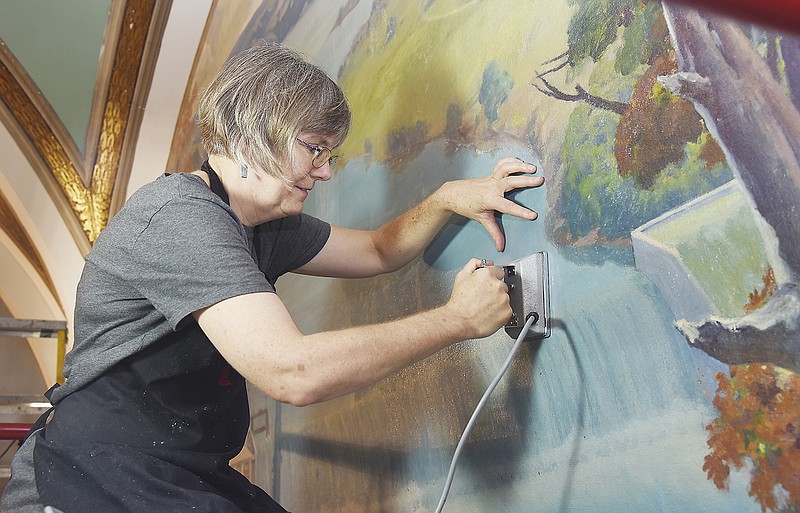Two women from Ohio are working hard to make sure Missourians can enjoy murals - and other artwork - in the Capitol for a long time to come.
Wendy Partridge and Andrea Chevalier work for the Cleveland, Ohio-based ICA Art Conservation Center, a nonprofit regional center which notes on its web page, ica-artconservation.org/about/, that it was "founded in 1952 by the directors of six major Midwestern museums to provide professional, high quality, and cost effective art conservation services."
Both women are fellows in the American Institute for Conservation of Historic and Artistic Works, and both have been doing art conservation work for around 35 years.
They're in Jefferson City now, working on the "Power From the Hills" mural (by Ralph Chelsea Ott) that's in the northwest corner of the second-floor mezzanine area overlooking the Capitol Museum.
Their work is "called 'conservation' and 'consolidation,'" Chevalier explained - work that, a reporter asked, could be described on a simple level as cementing the original paint back to its canvas.
Their work is part of a three-phase contract between Missouri's State Capitol Commission and the ICA, Commission Chair Dana Rademan Miller explained.
The ICA is part of a "very narrow field," she said, and were selected after the commission sent out a request for proposals.
Experts at Kansas City's Nelson-Atkins Museum said the ICA had extra expertise in conserving museum works and, as a nonprofit company, "they're doing this because they love what they do," as well as being well-qualified to do it.
Miller said the restoration work is important, because: "We have this amazing collection of art" created by the first Decoration Commission bought with money left-over from construction of the Capitol. "It's literally an art gallery" as well as a museum housed in the Capitol.
Miller said it's clear the mural suffered water damage over the years, although the source of that water isn't known.
Partridge said, "This painting has had problems from the get-go.
"It may have been because of the materials the artist chose, because all of the other murals in the Capitol are in really, very good condition."
Their work is slow and methodical - applying, then removing an adhesive to help the original paint get back on the canvas, then doing color-matching touch-up only as needed, during a future trip.
"This one, we think, probably has had flaking problems from the beginning," she said. "As we're cleaning up our adhesive residues, we're uncovering old areas of damage that were over-painted in the past.
"The old re-touching was done pretty quickly, so it covered up the original. As we're taking off the over-paint, we're also getting (back) to the original paint."
One of their major goals is to work so well that, when they're finished, no one will know they did anything.
"Conservation work is supposed to be invisible," Chevalier said.
Their current trip isn't their first.
"We came a year-and-a-half-ago to do the assessment of all the murals," Chevalier said - a trip Miller said was the first phase of the contract.
That assessment, Partridge noted, determined that "by and large, the murals here are in excellent condition."
The women were here about a year ago, Chevalier said, to "work on all the smaller lunettes," as well as in "the governor's office, the Senate galleries" and the Thomas Hart Benton mural in the House Lounge.
Partridge said those paintings needed only minor treatment, "and we didn't even work on all of them - some of them didn't need anything."
You don't have to come from an art background to be an art conservator, the women said.
Partridge explained, "The thing that people always say about conservation is, you get to spend more time with the art than just about anybody.
"People usually come to conservation from a background in art history, chemistry or the fine arts. It's an interesting combination of art and science and history that, I think for a lot of people, is just absolutely wonderful."
In her spare time, Partridge is a print-maker, a book artist and a teacher, but not a painter.
Chevalier came to conservation from an art history background, and first became interested in the field as a teenager.
"I always knew I wanted to work in a museum environment," she said. "When I found out about conservation - actually working with materials and the paint things themselves, that was what drew me to the profession."
In her spare time, she said, "I have other interests, like gardening and traveling."
Although some of their work is done on "easel-sized" paintings that often are shipped to the conservation center in Cleveland, there is also a lot of travel involved in their jobs.
"Most of our projects are in Ohio and surrounding states," Chevalier said. "We have a few projects every year that take us farther - like this project."
And which work is more complicated "depends on what condition issues are with the piece," Chevalier said. "Some murals could have very minor condition issues, and we can treat those very quickly, (while) some smaller-sized paintings could have major problems."
Larger projects are often more challenging "just because of the scale," Partridge said. "You have to work on (ladders or) scaffolding," you have to travel to them and, usually, can't remove them from the walls.
The art works "are an integral part of the (Capitol) building," Chevalier said. "In the 1920s, the Capitol Commission decided to commission artwork for this building.
"That was important to them, and I think it should still be important to us, to preserve what we have."
Partridge said, "Missouri is so lucky to have such a beautiful state Capitol, with such important artwork."

